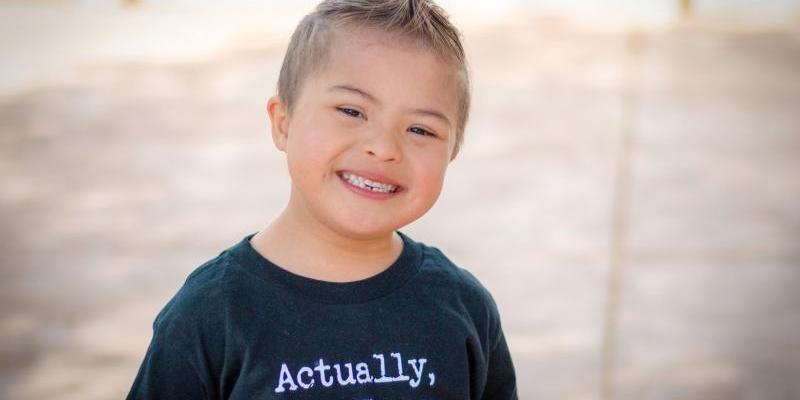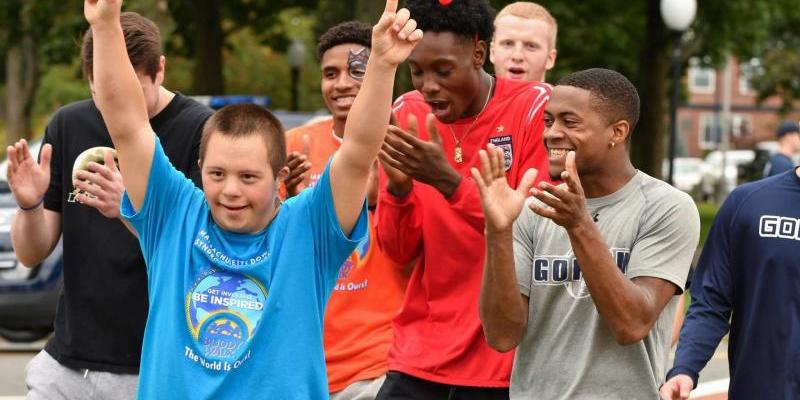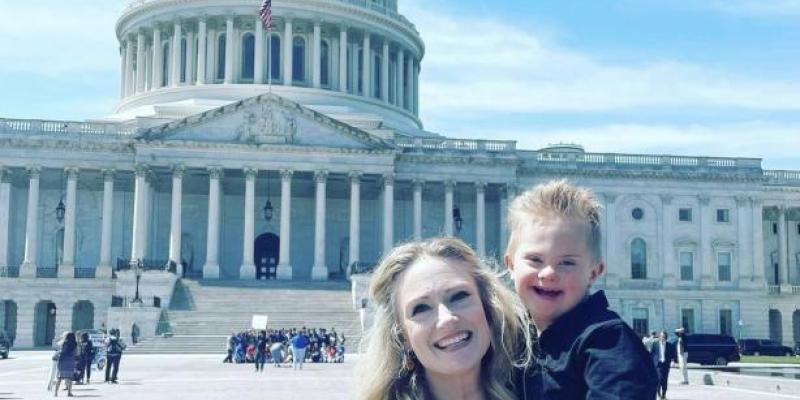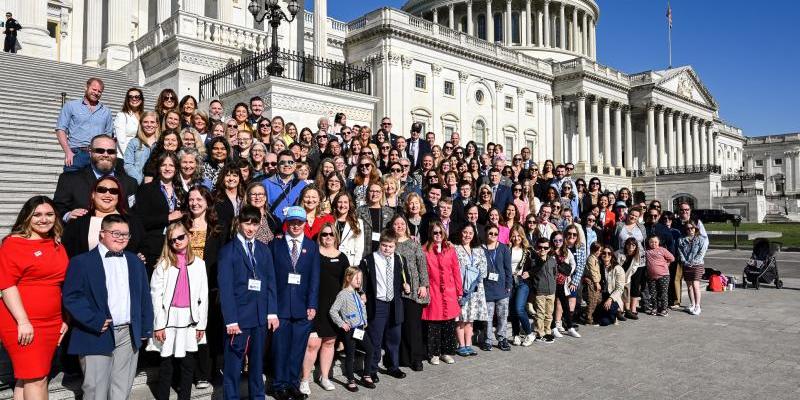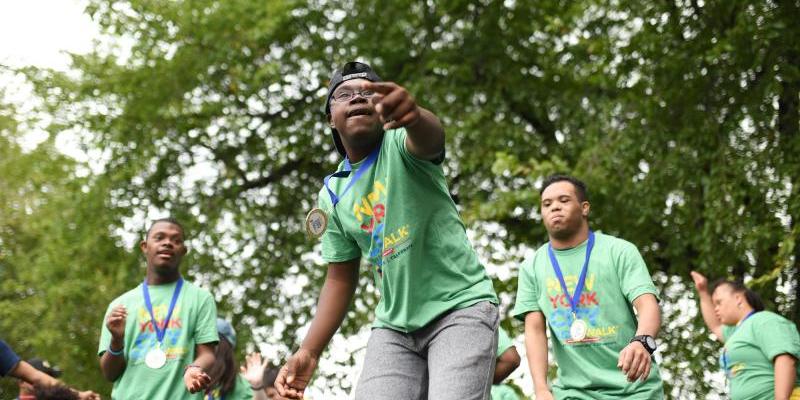Thinking About Tomorrow: The Transition to Adult Life
BY JO ANN SIMONS
ADAPTED FROM DISABILITY SOLUTIONS, VOLUME 6, ISSUE 1
The period of time between high school and what comes next is not a transition. That sounds like something that gets you from one place to another—like a bridge. It even sounds easy. In my experience, transition has been nothing short of a free fall. This article will illustrate some ways to survive. Families are surviving and thriving, though they have had to work hard.
Turning 21 or 22, or getting a diploma—whatever point your state has determined is the end of a free public education—is the beginning of the rest of your life. Everything will change. Nothing will be the same, but believe me, you will survive.
There are many skills you have learned in the years leading up to this transition that will become even more important. Skills that will help you navigate a daunting maze of rules and regulations regarding what is available to your child. The biggest difference between the years your child is in school and adulthood is that your child is not “entitled” to services.
There is no national or state law that entitles your child or your family to any assistance because your child has Down syndrome. There may not be any lawyers to hire or advocates to line up. Laws that do exist are carefully crafted with language such as “if funded” or “depending on allocation” and other jargon alerting you that anything you receive is subject to change depending on your state’s budget process.
SO, WHAT’S A FAMILY TO DO?
Prepare, prepare and act.
WHAT IS TRANSITION?
My son, Jon, is 25 and he has been my best teacher. My first advice to you is to listen to your children. They will lead you. Several years ago, after graduating from our local high school, Jon moved on to a post-graduate program, two hours from our home on Cape Cod. His birthday was approaching and I called to make plans for us to celebrate with him. He seemed hesitant to commit to a dinner with us. He asked an interesting question: “How many birthdays have you celebrated with me?” Nineteen was the obvious one since the birthday approaching was his twentieth. He paused for a moment and replied, “Then I think it is time for a change.” I was aghast, but not speechless. I came back with a quick, “It will be hard.” And his thoughtful reply was, “You’ll get used to it.” Transitions are a time of great change. You will get used to it.
Every year, millions of people around the world finish their secondary or high school studies and go on to something else. But, if you have Down syndrome or a related disability, we have named it. We have named it transition. Otherwise, it is just “What are you doing next year?”
Have you gone through the college application process with another child recently? If so, you looked at college catalogues, visited campuses, edited essays, fine-tuned resumes, sought out connections, and spent countless hours listening as your child chose the setting that fit his dreams, interests, and personality.
You will have to have the same level of involvement with your child who has Down syndrome as he leaves public education also.
Unfortunately, there are not many guidebooks to help. But, as always, we have each other and lots of families have gone before you to pave the way. Your job is to repair, refine, and redirect the path as needed for those who follow you.
My goal is to simplify this time in your life and demonstrate to you that you already have all the knowledge and most of the tools to support your son or daughter during this transition. This article provides a general road map and some useful tips to use along the way.
WHAT ARE THE OPTIONS?
Think back to your own experiences. Recall your own high school years or, if that is too distant, perhaps you have a child who has recently graduated from high school.
Somewhere in your junior year you began to think about what you were going to do when you graduated. But most of use waited until our senior year to do the thinking. So what did everyone decide?
Here is what happens to a typical senior class:
- Some of our classmates went directly to work.
- Some of our classmates went to trade schools.
- Some of our classmates joined the armed services.
- Some of our classmates went to community colleges and lived at home.
- Some of our classmates went off to 4-year colleges.
- Some of them lived at home others lived on campus.
- The majority of our classmates stayed within a 1-2 hour drive from home.
In every graduating class, people with developmental disabilities will make a variety of choices for their life after the end of their public education.
Expect the same for people with developmental disabilites:
- Some will go directly to work.
- Some will go to trade schools.
- Some will go to community colleges and live at home.
- Very few, if any, will join the armed forces, though they may want to.
- Some will go to 4-year colleges or other post secondary programs.
- Some will live at home; others will live on campus or in apartments.
- The majority will stay within a 1-2 hour drive from home.
Outside of the initial diagnosis, families believe the most difficult time in the life of a parent of a child with a developmental disability, is the transition from school to adult life. What makes this so difficult is that the process is really a series of decisions and transitions that take many years. It requires much effort, planning, and time on the part of families.
A VISION FOR LIFE AFTER HIGH SCHOOL
We all have to start somewhere and a vision is good place to begin.
What is your vision for your child after high school? What is your child’s vision? Are they the same, or even close? A vision begins with, and focuses on, your child’s interests, abilities, and dreams. Some families have a vision they share throughout their child’s life, altering it as his interests change. Other families need more structure and discussion to begin to develop a vision. Many families use a process called person centered planning to develop a vision and a series of action plans to reach that vision. Person centered planning is a process of learning what your child’s dreams are, assessing what needs to be accomplished, and creating action plans that lay out steps toward each goal. Some better known methods for doing this are called, mapping (MAPS) and group action planning (GAP).
We did not use a formal process to determine a vision for Jon.
Instead, we listened to Jon. His vision began taking root in his early years of high school when he expressed his preference for an inclusive education setting. As a sophomore, he began to ask about taking the SAT’s and going to college. Inclusive education meant he spent his days in our local high school surrounded by students planning to go to college. In a high school that sends 87% of its students to college, Jon did not meet too many kids who were planning on work or the military after high school.
Jon’s roadmap included visits to 4-year colleges, community colleges, and specialized post secondary residential programs. We filled out applications, went on interviews, took tests and we “marketed” him to prospective schools. It was a long and thoughtful process and it took several years. In the end, all our work and effort paid off as Jon had choices in May of his senior year. He decided to attend the GROW (Getting Ready for the Outside World) program of the Riverview School in East Sandwich, MA and co-enrolled at the Cape Cod Community College in a program designed for students with developmental disabilities. In doing so, he turned down the opportunity to become the first and only student to attend a four-year college in Massachusetts as a non
degree-seeking special student, an opportunity to attend a college in
New York, or stay in our community and get a job.
THE TRANSITION CHECKLIST
Along with the vision, it is important to have a tangible idea of your child’s skills related to the real world to help you identify what to address. This is not a test or assessment. It is an opportunity to see the skills your child has and what areas you may have overlooked. It is helpful to use when you need to describe your child to an admissions officer or whoever is the gatekeeper to whatever it is you and your child decide you want for a transition. This checklist provides some general areas to consider.
Use the transition checklist to identify goals to build into your child’s I.E.P. and your home routines during the transition years (age 14-21). Keep in mind the checklist is very broad. Some areas your child has already mastered.
Others will require some thought regarding the steps involved and which of those your child needs to work on. Although some of these areas may not be important to you, they are likely the types of questions others will have for you about your child when considering life after public education.
CHOICES ABOUT GRADUATION
Another important aspect to leaving school is graduation. The first item to consider is when does secondary school education in the high school environment end? Like everything in your child’s life, this is specific to each individual. For some students with developmental disabilities, it ends after four years of high school and for others it may end after five, six or seven years. It might depend on how old your child is and that may depend on decisions you made many years ago. Some families kept their young children back several years and others wanted their children to stay with their peers. Each of us made different decisions then and each of us will make different decisions now.
Our guides will be our children and our own personal values.
Every state establishes guidelines for issuing a diploma. They usually consist of completing a certain set of courses and some tests students must pass to prove competency in educational standards. Most students eagerly anticipate the earliest graduation date possible. For many students in special education who have significant needs, and almost all of those with Down syndrome, “graduating” has several definitions. “Graduating” may mean walking across the stage to receive a diploma. But in many communities, once a student— even those in special education— receives a diploma, it means you agree that a Free and Appropriate Education (FAPE) is complete.
However, for most families of children with Down syndrome, “graduating” is an important life cycle event rather than an acceptance of a diploma or the end of FAPE. It is very important to know the local rules and customs so you are not caught off-guard. Make sure your choices are informed ones.
My son graduated with his class, received several senior awards, and over $6000 in scholarships. But he did not receive an actual diploma. He walked across the stage and was handed a folder that looked the same as everyone else’s, but rather than having a diploma inside, it was a “certificate of attendance.” When Jon turned 22 years old—the age FAPE ends in Massachusetts— I picked up his actual diploma in the principal’s office. We did not take the actual diploma when he graduated with his friends to ensure our school district would continue to provide him with the educational supports he continued to need.
Your choice will depend on several factors: financial, emotional, and practical. What is important is that you understand why you are choosing one over the other and the implications of making that choice.
AFTER GRADUATION
After you decide how long your child will be in high school, it is time to plan for what comes next. Don’t wait until your child graduates to begin thinking about these topics. Each one requires considerable time and effort from parents and those who support your family. It is wise to begin researching what is available and building partnerships with others to create a situation that is unique for your child.
There are several areas to think about that fit into three main categories: employment, living arrangements, and leisure time. Each category is filled with choices, options, and financial needs to consider. There is no right or wrong order to tackle them. Some families will focus on living arrangements first while others will work on finding stable employment or leisure opportunities. These decisions will likely depend on programs and waiting lists for those programs in your community. Start early, ask questions of friends and professionals, and make informed decisions that support your child’s vision for their life.
MAKING IT HAPPEN
The leap from knowing what options exist to making your vision a reality is often very difficult, but as David Lloyd George said, “Don’t be afraid to take a big step if one is indicated. You can’t cross a chasm in two small steps.” It is very important to take a moment and dwell on this. As families, we have been told to appreciate the small steps, the small achievements and the small successes of our child. The truth is that sometimes, big things require big steps. They require risk.
Suppose you have a vision. You have even developed a Person Centered Plan. You know what you want and maybe even how to get there. How do you pay for it? Here is where you have to be creative and a little luck is helpful.
FUNDING OPTIONS
First of all you need to know what sources of income you have at your disposal. The following are some categories for potential sources of funding to consider to identify income you have presently and areas where you might be able to find additional support:
- Wages
- SSI (Supplemental Security Income)/SSDI (Social Security Disability Income) www.ssa.gov/about.htm
- DMR or other state agency support (including Voc. Rehab)
- Family contributions
- Section 8 or other housing subsidy www.hud.gov/offices/pih/ programs/hcv/index.cfm
- Medicaid or other health insurance cms.hhs.gov/medicaid
- Medicaid Waiver Programs: Each state has a variety of waivers designed to promote community living. The waivers are specific to each state.
Each of these funding options is a complex and sometimes confusing maze to navigate that goes beyond the scope of this article. Be a good investigator and know what the limitations of each funding program are so you are not caught off-guard and lose that money or the benefits you are depending on. Ask other parents as well as those within the programs. Let their experience and knowledge guide you.
FRIENDSHIPS AND FREE TIME
Now comes the hardest part: developing a satisfying and sustainable social network. To put it simply, this means having something to do and some people to do it with. Most families find the loss of the activities of school life difficult to replicate. Too often TV becomes a time-consuming friend. This is the time that you will need to seek out community and specialty social activities. Most of us have come to realize that the friendships we had hoped would sustain our children never materialized. Some of us encouraged relationships in unique and creative ways and others are grateful for Special Olympics, parks and recreation programs, and recreation programs of the Arc’s. In some areas there are Ameri Corps volunteers and personal assistants working with recreation programs to encourage community inclusion. Check with your local program to see what support they have available to include your child if needed. Most of us have used a combination of all these options.
In our situation, Jon has developed a social network of work friends, friends with disabilities, paid staff, and family members. The Massachusetts Department of Mental Retardation, his salary, SSI, Section 8, and food stamps support him. He has a valued job at the Camp Lyndon Center of the Cape Cod YMCA and lives with a roommate in a community, supported by LIFE, Inc. in his own home. He helps direct support from his personal care attendant, Mary, who he considers a friend. A cell phone provides all of us with some increased measure of comfort. It helped when he was lost at the Fleet Center and when he lost power in his house. But, everyday, since he lives two hours from us, Jon is allowed to take the risks that come with increased dignity and for that he is very proud.
We usually visit Jon at least twice a month, but during football season it can increase to weekly, so he can watch the New England patriots with his father. They give me a shopping list for the grocery store. Recently, he requested that I not visit. He told me, “I need a break from you”. When I pressed him, he said, “When you were my age, didn’t you need a break once in awhile from your mother?” I resisted my temptation to make him feel guilty and while I was a bit hurt, I celebrated his ability to advocate for his own needs.
FINAL WORDS OF ADVICE
Finally, I have some advice to dispense to you. Like the hit song several graduation seasons ago, I’ll start off by telling you to use sunscreen because it is the only advice that has been scientifically proven. The rest is based on my observations over the past 20 years of being both a parent and someone who is responsible for providing services to individuals with developmental disabilities.
Teach your children how to use a bathroom-by themselves.
Resist the temptation to assist your child in the bathroom at an age when he should be doing it himself.
Make sure your child knows how to shower—ALONE. It is not a group activity.
Make sure your child knows that showering is, however, a daily activity. It’s also a rule. Make no exceptions to this rule. If in doubt, shower twice a day.
Wearing clean clothes is essential. Changing them every day is important.
Teach your child to do his laundry. Show him stains on clothing so he knows what to look for and not to wear clothes with stains.
While I am on the subject of clothes, if there is a choice, buy the next larger size. If someone hasn’t told you this yet, let me be the first: people do not look good in clothes that are too tight.
Food is fuel. The wrong types slow you down and good food gives you energy. If your child eats the wrong food, he will look wrong. If he eats the right foods, he will look right. It’s that simple.
Do not let anyone tell you that your child cannot learn to read, or learn more, or read better than they do today. Learning never ends.
Respect. We all want it. Many of us want our children to receive it but, truth be told, you and your child must be willing to give it. Then it will come.
Make sure your child knows he needs to do what the boss tells him, whoever the boss may be.
Remember daytime is for being awake and nighttime for sleeping. Some people still don’t get it.
Adults work. Many teenagers work, too. Your child should work. Somewhere.
SSI guarantees a monthly income. It does not guarantee self-respect.
Don’t blame someone else for mistakes. You set a bad example. Mistakes are inevitable. Learn from them and move on.
Don’t expect siblings to be the parents. Brothers and sisters want information-lots of information. That is not the same thing as wanting responsibility.
Finally, if you don’t teach your child to cross the street, he will never know what’s on the other side.
Neither will you.
***
JoAnn resides with her husband in Swampscott, Massachusetts while her children, Jon, who has Down syndrome, and Emily, create their own, independent lives.


